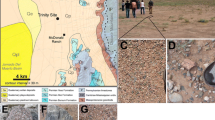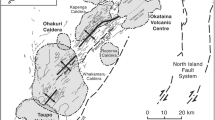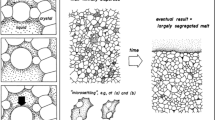Abstract
We present major element and actinide composition data from a population of fallout glass samples produced from a single near-surface nuclear detonation. Glass major element compositions indicate that composition of local geology is a primary control on bulk fallout chemical composition. Uranium isotope compositions indicate that vaporized, residual fuel was incorporated into the melts prior to solidification, likely within seconds, and are consistent with two-component mixing between naturally-occurring uranium and residual uranium fuel. Model ages of the residual fuel in fallout are systematically inaccurate, biased towards older ages, and are consistent with two-component mixing between naturally-occurring daughter nuclides in local sediment and decay-derived daughter nuclides from residual nuclear fuel. Multiple processes such as mixing, agglomeration of melted sediment-derived droplets, and incorporation of condensates must all occur within the timescale between sediment melting and melt solidification.








Similar content being viewed by others
References
Glasstone S, Dolan PJ (1977) The Effects of Nuclear Weapons. US DOD and US DOE. US Government Printing Office: 1977 O-213-794, Washington
Cassata WS, Prussin SG, Knight KB, Hutcheon ID, Isselhardt BH, Renne PR (2014) When the dust settles: applications of stable xenon isotopes to the formation of nuclear fallout. J. Environ Radioact. (in press)
Adams CE, Farlow NH, Schell WR (1960) The composition, structures and origins of radioactive fall-out particles. Geochim Cosmochim Acta 18:42–56
Hermes RE, Strickfaden WB (2005) A new look at trinitite. Nucl Weapons J 2:2–7
Parekh PP, Semkow TM, Torres MA, Haines DK, Cooper JM, Rosenberg PM, Kitto ME (2006) Radioactivity in trinitite six decades later. J Environ Radioact 85:103–120
Eby N, Hermes R, Charnley N, Smoliga JA (2010) Trinitite – the atomic rock. Geol Today 26:181–186
Fahey AJ, Zeissler CJ, Newbury DE, Davis J, Lindstrom RM (2010) Post-detonation nuclear debris for attribution. P Natl Acad Sci USA 107:20207–20212
Belloni F, Himbert J, Marzocchi O, Romanello V (2011) Investigating incorporation and distribution of radionuclides in trinitite. J Environ Radioact 102:852–862
Bellucci JJ, Wallace C, Koeman EC, Simonetti A, Burns PC, Kieser J, Port E, Walczak T (2012) Distribution and behavior of some radionuclides associated with the Trinity nuclear test. J Radioanal Nucl Chem 295:2049–2057
Bellucci JJ, Simonetti A (2012) Nuclear forensics: searching for nuclear device debris in trinitite-hosted inclusions. J Radioanal Nucl Chem 293:313–319
Bellucci JJ, Simonetti A, Wallace C, Koeman EC, Burns PC (2013) Isotopic fingerprinting of the world’s first nuclear device using post-detonation materials. Anal Chem 85:4195–4198
Bellucci JJ, Simonetti A, Wallace C, Koeman EC, Burns PC (2013) Lead isotopic composition of trinitite melt glass: evidence for the presence of Canadian industrial lead in the first atomic weapon test. Anal Chem 85:7588–7593
LaMont SP, Hall G (2005) Uranium age determination by measuring the 230Th/234U ratio. J Radioanal Nucl Chem 264:423–427
Varga Z, Surányi G (2007) Production date determination of uranium-oxide materials by inductively coupled plasma mass spectrometry. Anal Chim Acta 599:16–23
Williams RW, Gaffney AM (2011) 230Th–234U model ages of some uranium standard reference materials. Radiochim Acta 1:31–35
Eppich GR, Williams RW, Gaffney AM, Schorzman KC (2013) 235U–231Pa age dating of uranium materials for nuclear forensic investigations. J Anal Atom Spectrom 28:666–674
Lewis L (2012) Characterizing the distribution of unfissioned fuel in quasi-spherical glasses created by a low-yield surface nuclear explosion. M.S. Thesis. University of California, Berkeley
Steiger RH, Jäger E (1977) Subcommission on geochronology: convention on the use of decay constants in geo- and cosmochronology. Earth Planet Sci Lett 36:359–362
Cowan GA, Adler HH (1976) The variability of the natural abundance of 235U. Geochim Cosmochim Acta 40:1490–1498
Brennecka GA, Borg LE, Hutcheon ID, Sharp MA, Anbar AD (2010) Natural variations in uranium isotope ratios of uranium ore concentrates: understanding the 238U/235U fractionation mechanism. Earth Planet Sci Lett 291:228–233
Richter S, Alonso A, De Bolle W, Wellum R, Taylor PDP (1999) Isotopic “fingerprints” for natural uranium ore samples. Int J Mass Spectrom 193:9–14
Kigoshi K (1971) Alpha-recoil thorium-234: dissolution into water and the uranium-234/uranium-238 disequilibrium in nature. Science 173:47–48
Fleischer RL, Raabe OG (1978) Recoiling alpha-emitting nuclei. Mechanisms for uranium-series disequilibrium. Geochim Cosmochim Acta 42:973–978
Zhao X-L, Nadeau M-J, Kilius LR, Litherland AE (1994) The first detection of naturally-occurring 236U with accelerator mass spectrometry. Nucl Instrum Methods Phys Res B 92:249–253
Acknowledgments
The authors acknowledge Ross Williams for his invaluable guidance on actinide chemical separations and isotopic analyses. Rachel Lindvall and Zurong Dai are thanked for their instruction on and assistance with quadrupole ICPMS and SEM analyses, respectively. William Cassata, Stanley Prussin, Brett Isselhardt, and two anonymous reviewers provided useful comments that led to the improvement of the manuscript. This work performed under the auspices of the U.S. Department of Energy by Lawrence Livermore National Laboratory under Contract DE-AC52-07NA27344. This work was funded by the Laboratory Directed Research and Development Program at Lawrence Livermore National Laboratory under project tracking code 13-ERD-062, as well as with support by the Office of Defense Nuclear Nonproliferation Research and Development within the U.S. Department of Energy’s National Nuclear Security Administration. LLNL-JRNL-650394.
Author information
Authors and Affiliations
Corresponding author
Rights and permissions
About this article
Cite this article
Eppich, G.R., Knight, K.B., Jacomb-Hood, T.W. et al. Constraints on fallout melt glass formation from a near-surface nuclear test. J Radioanal Nucl Chem 302, 593–609 (2014). https://doi.org/10.1007/s10967-014-3293-9
Received:
Published:
Issue Date:
DOI: https://doi.org/10.1007/s10967-014-3293-9




